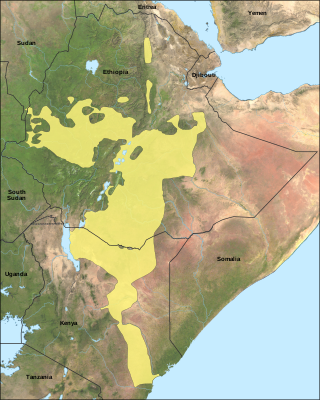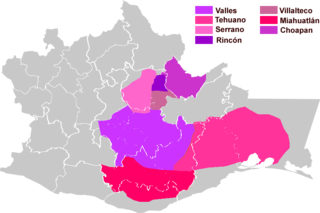The Finnish language is spoken by the majority of the population in Finland and by ethnic Finns elsewhere. Unlike the Indo-European languages spoken in neighbouring countries, such as Swedish and Norwegian, which are North Germanic languages, or Russian, which is a Slavic language, Finnish is a Uralic language of the Finnic languages group. Typologically, Finnish is agglutinative. As in some other Uralic languages, Finnish has vowel harmony, and like other Finnic languages, it has consonant gradation.

Oromo, historically also called Galla, which is regarded by the Oromo as pejorative, is an Afroasiatic language that belongs to the Cushitic branch. It is native to the Ethiopian state of Oromia and northern Kenya and is spoken predominantly by the Oromo people and neighboring ethnic groups in the Horn of Africa. It is used as a lingua franca particularly in the Oromia Region and northeastern Kenya.

Neo-Mandaic, also known as Modern Mandaic, sometimes called the "ratna", is the modern reflex of the Mandaic language, the liturgical language of the Mandaean religious community of Iraq and Iran. Although severely endangered, it survives today as the first language of a small number of Mandaeans in Iran and in the Mandaean diaspora. All Neo-Mandaic speakers are multilingual in the languages of their neighbors, Arabic and Persian, and the influence of these languages upon the grammar of Neo-Mandaic is considerable, particularly in the lexicon and the morphology of the noun. Nevertheless, Neo-Mandaic is more conservative even in these regards than most other Neo-Aramaic languages.

Maidu, also Northeastern Maidu or Mountain Maidu, is an extinct Maiduan language of California, United States. It was spoken by the Maidu peoples who traditionally inhabit the mountains east and south of Lassen Peak in the American River and Feather River basins. These river regions include such valleys in the northern Sierra Nevada mountains of California as: Indian Valley, American Valley, Butte Valley, and Big Meadows. Maidu may also refer to the related Konkow and Nisenan languages.
The Ojibwe language is an Algonquian North American indigenous language spoken throughout the Great Lakes region and westward onto the northern plains. It is one of the largest indigenous language north of Mexico in terms of number of speakers, and exhibits a large number of divergent dialects. For the most part, this article describes the Minnesota variety of the Southwestern dialect. The orthography used is the Fiero Double-Vowel System.
In Hebrew, verbs, which take the form of derived stems, are conjugated to reflect their tense and mood, as well as to agree with their subjects in gender, number, and person. Each verb has an inherent voice, though a verb in one voice typically has counterparts in other voices. This article deals mostly with Modern Hebrew, but to some extent, the information shown here applies to Biblical Hebrew as well.
While other word categories in Ilocano are not as diverse in forms, verbs are morphologically complex inflecting chiefly for aspect. Ilocano verbs can also be cast in any one of five foci or triggers. In turn, these foci can inflect for different grammatical moods.
Apma is the language of central Pentecost island in Vanuatu. Apma is an Oceanic language. Within Vanuatu it sits between North Vanuatu and Central Vanuatu languages, and combines features of both groups.
Sesotho verbs are words in the language that signify the action or state of a substantive, and are brought into agreement with it using the subjectival concord. This definition excludes imperatives and infinitives, which are respectively interjectives and class 14 nouns.
Bororo (Borôro), also known as Boe, is the sole surviving language of a small family believed to be part of the Macro-Jê languages. It is spoken by the Bororo, hunters and gatherers in the central Mato Grosso region of Brazil.

The Nukak language is a language of uncertain classification, perhaps part of the macrofamily Puinave-Maku. It is very closely related to Kakwa.
Dirasha is a member of the Cushitic branch of the Afro-Asiatic family. It is spoken in the Omo region of Ethiopia, in the hills west of Lake Chamo, around the town of Gidole.

In linguistic morphology, inflection is a process of word formation in which a word is modified to express different grammatical categories such as tense, case, voice, aspect, person, number, gender, mood, animacy, and definiteness. The inflection of verbs is called conjugation, while the inflection of nouns, adjectives, adverbs, etc. can be called declension.
This article deals with the grammar of the Udmurt language.

Avá-Canoeiro, known as Avá or Canoe, is a minor Tupi–Guaraní language of the state of Goiás, in Brazil. It can be further divided into two dialects: Tocantins Avá-Canoeiro and Araguaia Avá-Canoeiro. All speakers of the language are monolingual.
Tlacolula Valley Zapotec or Valley Zapotec, known by its regional name Dizhsa, and formerly known by the varietal name Guelavia Zapotec is a Zapotec language of Oaxaca, Mexico.
Arabic verbs, like the verbs in other Semitic languages, and the entire vocabulary in those languages, are based on a set of two to five consonants called a root. The root communicates the basic meaning of the verb, e.g. ك-ت-ب k-t-b 'write', ق-ر-ء q-r-ʾ 'read', ء-ك-ل ʾ-k-l 'eat'. Changes to the vowels in between the consonants, along with prefixes or suffixes, specify grammatical functions such as person, gender, number, tense, mood, and voice.
This article describes the grammar of the Old Irish language. The grammar of the language has been described with exhaustive detail by various authors, including Thurneysen, Binchy and Bergin, McCone, O'Connell, Stifter, among many others.
Hindustani verbs conjugate according to mood, tense, person, number, and gender. Hindustani inflection is markedly simpler in comparison to Sanskrit, from which Hindustani has inherited its verbal conjugation system. Aspect-marking participles in Hindustani mark the aspect. Gender is not distinct in the present tense of the indicative mood, but all the participle forms agree with the gender and number of the subject. Verbs agree with the gender of the subject or the object depending on whether the subject pronoun is in the dative or ergative case or the nominative case.
Turkmen grammar is the grammar of the Turkmen language, whose dialectal variants are spoken in Turkmenistan, Iran, Afghanistan, Russia, China, Uzbekistan, Tajikistan and others. Turkmen grammar, as described in this article, is the grammar of standard Turkmen as spoken and written by Turkmen people in Turkmenistan.






